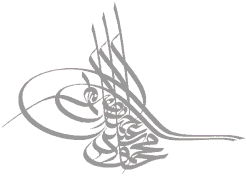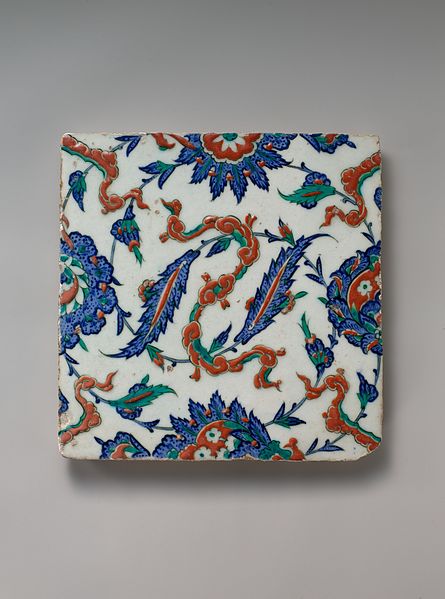The Greatest Contribution of the Ottoman Empire to the World of Art Was

The Turks absorbed, adapted and modified the cultures of conquered lands and their peoples.

Curated/Reviewed by Matthew A. McIntosh
Public Historian
Brewminate
Introduction
Ottoman civilization evolved over several centuries as the ruling administration of the Turks absorbed, adapted and modified the cultures of conquered lands and their peoples. There was a strong influence from the customs and languages of Islamic societies, notably Arabic, while Persian culture had a significant contribution through the heavily Persianized Seljuq Turks, the Ottomans' predecessors. Despite newer added amalgamations, the Ottoman dynasty, like their predecessors in the Sultanate of Rum and the Seljuk Empire, were thoroughly Persianised in their civilization, language, habits and customs, and therefore, the empire has been described as a Persianate empire."[ane][2][3][four] Throughout its history, the Ottoman Empire had substantial subject area populations of Orthodox subjects, Armenians, Jews and Assyrians, who were allowed a sure amount of autonomy nether the confessionalmillet system of Ottoman government, and whose distinctive cultures enriched that of the Ottoman state.
Equally the Ottoman Empire expanded it assimilated the civilization of numerous regions under its dominion and beyond, being peculiarly influenced by Byzantium, the Arab culture of the Islamic Middle East, and the Western farsi civilisation of Iran.
Literature
Verse
A large number of Persian loanwords entered the literary linguistic communication, and Persian metres and forms (such as those ofGhazal) were used.
By the 19th century and the era of Tanzimat reforms, the influence of Turkish folk literature, until then largely oral, began to appear in Turkish poetry, and there was increasing influence from the literature of Europe; there was a respective decline in classical courtroom poetry. Tevfik Fikret, born in 1867, is ofttimes considered the founder of modern Turkish poetry.
Prose
Prior to the 19th century, Ottoman prose was exclusively non-fictional, and was much less highly developed than Ottoman verse, in office because much of it followed the rules of the originally Arabic tradition of rhymed prose (Saj'). Nevertheless, a number of genres – the travelogue, the political treatise and biography – were current.
From the 19th century, the increasing influence of the European novel, and peculiarly that of the French novel, began to be felt. Şemsettin Sami'sTaaşuk-u Tal'at ve Fitnat, widely considered the showtime Turkish novel, was published in 1872; other notable Ottoman writers of prose were Ahmet Mithat and Halit Ziya Uşaklıgil.
Architecture
Ottoman architecture was a synthesis of Iranian-influenced Seljuk architectural traditions, as seen in the buildings of Konya, Mamluk architecture, and Byzantine compages; it reached its greatest development in the large public buildings, such as mosques and caravanserais, of the 16th century.
The near significant figure in the field, the 16th-century architect and engineer Mimar Sinan, was a Muslim catechumen of Armenian descent, having a background in the Janissaries. His most famous works were the Selimiye Mosque in Edirne and the Suleiman Mosque in Constantinople. One of his pupils, Sedefkar Mehmed Agha, designed the early 17th century Bluish Mosque, considered the last slap-up building of classical Ottoman architecture.
Decorative Arts
Calligraphy

Calligraphy had a prestigious condition under the Ottomans, its traditions having been shaped past the work of Abbasid calligrapher Yaqut al-Musta'simi of Baghdad, whose influence had spread across the Islamic earth, al-Musta'simi himself possibly being of Anatolian origin.
The Diwani script is a cursive and distinctively Ottoman style of Arabic calligraphy developed in the 16th and early 17th centuries. Information technology was invented by Housam Roumi, reaching its greatest development under Süleyman I the Magnificent (1520–66). The highly decorative script was distinguished by its complexity of line and past the close juxtaposition of the letters within words. Other forms included the flowing, rounded Nashki script, invented by the tenth-century Abbasid calligrapher Ali Muhammad ibn Muqlah, and Ta'liq, based on the Persian Nastalīq style.
Noted Ottoman calligraphers include Seyyid Kasim Gubari, Şeyh Hamdullah, Ahmed Karahisari, and Hâfiz Osman.
Miniatures
The Ottoman tradition of painting miniatures, to illustrate manuscripts or used in dedicated albums, was heavily influenced by the Persian art form. A Greek academy of painters, theNakkashane-i-Rum was established in the Topkapi Palace in the 15th century, while early on in the following century a similar Farsi academy, theNakkashane-i-Irani, was added.
Carpet-Weaving and Textile Arts

Tile with Floral and Cloud-band Blueprint, c. 1578, Iznik Tile, Ottoman Empire, in the collection of the Metropolitan Museum of Art. [five] / Metropolitan Museum of Art, Wikimedia Eatables
The art of carpet weaving was particularly significant in the Ottoman Empire, carpets having an immense importance both every bit decorative furnishings, rich in religious and other symbolism, and equally a practical consideration, equally it was customary to remove one's shoes in living quarters.[6] The weaving of such carpets originated in the nomadic cultures of fundamental Asia (carpets beingness an easily transportable course of furnishing), and was eventually spread to the settled societies of Anatolia. Turks used carpets, rugs and patterned kilims not just on the floors of a room, but also as a hanging on walls and doorways, where they provided additional insulation. They were likewise usually donated to mosques, which often amassed big collections of them.[7]

Hereke carpets were of peculiarly high status, being made of silk or a combination of silk and cotton, and intricately knotted. Other significant designs included "Palace", "Yörük", Ushak, and Milas or "Türkmen" carpets. "Yörük" and "Türkmen" represented more than stylized designs, whereas naturalistic designs were prevalent in "Palace".
Jewelry
The Ottoman Empire was noted for the quality of its golden- and silversmiths, and specially for the jewelry they produced. Jewelry had particular importance as information technology was normally given at weddings, every bit a gift that could be used as a form of savings.[eight] Argent was the most mutual material used, with gold reserved for more high-status pieces; designs often displayed circuitous grid work and incorporated Persian and Byzantine motifs. Developments in design reflected the tastes of the Ottoman courtroom, with Western farsi Safavid fine art, for case, becoming an influence after the Ottoman defeat of Ismail I after the Boxing of Chaldiran in 1514.[9] In the rural areas of the Empire, jewelry was simpler and often incorporated gold coins (the Ottomanaltin), but the designs of Constantinople nevertheless spread throughout Ottoman territory and were reflected fifty-fifty in the metalwork of Arab republic of egypt and North Africa.
Nigh jewelers and goldsmiths were Christian Armenians and Jews, merely the interest of the Ottomans in the related fine art of watchmaking resulted in many European goldsmiths, watchmakers and precious stone engravers moving to Constantinople, where they worked in the foreigners' quarter, Galata.[x]
Performance
Music

Apart from the music traditions of its constituent peoples, the Ottoman Empire evolved a distinct style of court music, Ottoman classical music. This was a principally vocal course, with instrumental accompaniment, congenital onmakamlar, a set of melodic systems, with a corresponding ready of rhythmic patterns chosenusul.
Another distinctive feature of Ottoman music were themehterân, the military machine bands used past the Janissaries and in the retinues of loftier-ranking officials. These bands were the ancestors of modern military bands, as well every bit of the brass ensembles pop in traditional Balkan music.
Trip the light fantastic
Dancing was an of import element of Ottoman civilization, which incorporated the folkloric dancing traditions of many unlike countries and lands on iii continents; from the Balkan peninsula and the Blackness Sea regions to the Caucasus, the Middle E and North Africa.
Dancing was also one of the most pop pastimes in the Harem of Topkapı Palace.
The female abdomen dancers, namedÇengi, were mostly from the Roma community. Today, living in Istanbul's Roma neighbourhoods like Sulukule, Kuştepe, Cennet and Kasımpaşa, they still boss the traditional belly dancing and musical entertainment shows throughout the metropolis's traditional taverns.
There were also male dancers, namedKöçek, who took part in the entertainment shows and celebrations, accompanied past circus acrobats, namedCambaz, performing difficult tricks, and other shows which attracted marvel.
Meddah (One-Person Show)
Themeddah or story teller played in front of a small group of viewers, such equally a coffeehouse audience. The play was mostly nigh a single topic, themeddah playing dissimilar characters, and was commonly introduced by cartoon attention to the moral contained in the story. Themeddah would use props such as an umbrella, a handkerchief, or different headwear, to signal a modify of grapheme, and was skilled at manipulating his voice and imitating unlike dialects. There was no time limitation on the shows; a goodmeddah had the skill to suit the story depending on interaction with the audience.
Meddahsouth were generally traveling artists whose route took them from 1 large urban center to another, such along the towns of the spice road; the tradition supposedly goes dorsum to Homer'south time. The methods ofmeddahsouth were the same as the methods of the itinerant storytellers who related Greek epics such every bit theIliadandOdyssey, even though the principal stories were now Ferhat ile Şirin or Layla and Majnun. The repertoires of themeddahs also included truthful stories, modified depending on the audition, artist and political situation.
The Istanbulmeddahs were known to integrate musical instruments into their stories: this was a main difference between them and the East Anatolian Dengbejin.
In 2008 the art of themeddahs was relisted in the Representative Listing of the Intangible Cultural Heritage of Humanity.
Karagöz (Shadow Play)
The Turkish shadow theatre, also known equally Karagöz ("Black-Eyed") after i of its primary characters, is descended from the Oriental Shadow theatre. Today, scholars generally consider the technique of a single puppeteer creating voices for a dialogue, narrating a story, and possibly even singing, all while manipulating puppets, to exist an Indonesian invention.
Median (Open-Stage Testify)
In the Ottoman Empire, theatre in the western sense began to be performed after the Tanzimat era (Sağlam 1999). The first Turkish play "Şair Evlenmesi" (The spousal relationship of the poet) was written by İbrahim Şinasi in 1859. It was a one-act inspired by Moliere's plays. Used to being entertained by traditional folk theatre and village shows, the Turkish people's favourite genre of western theatre was the one-act.
Scenario, UCC
Sports
The Jewish Gymnastics Club of Constantinople, founded in 1895, was the first of Istanbul'south sports clubs, before long followed by Kurtuluş Sports Gild founded in 1896 by Ottoman Greeks.[11] The opening of these athletic clubs symbolized a general growth in sports and sports culture in Istanbul at the fourth dimension. In the coming years, Beşiktaş Gymnastics Guild, the Galatasaray Sports Social club, and the Fenerbahçe Sports Club — Istanbul's "big 3" — were founded.[12] Exercise, as well as football and gymnastics were commonplace among the primarily affluent members of these clubs. In contrast to the adequately exclusive "big three", Vefa Sports Social club, established after the progressive Young Turk revolution in 1908, served as an amateur sports and football club of the people.[12]
The turn of the twentieth century saw clubs spring up throughout Istanbul to appeal to many niches of young men, whether Muslim, Christian, or Jewish.[13] Almost all athletic clubs were ethnically and religiously homogeneous, notwithstanding they all shared a focus on physicality.[14] Furthermore, the function of these institutions expanded beyond sports, as they taught young men proper hygiene, dress, and posture, in add-on to serving as environments for male discourse and socializing.[xiii]
The development of athletic clubs enabled the rise of squad sports in Istanbul — principally football game — serving every bit contrasts to the more than traditional Ottoman sports of oil wrestling and archery.[15] For instance, upon its opening in 1905, Galatasaray functioned exclusively as a football game order.[16] This shift toward team competition represented a full general modernization of sports in Istanbul, a modernization that can besides be seen, for example, in the Beşiktaş Gymnastics Guild equally traditional Turkish wrestling embraced new mat technology.[17]
Athletic clubs revolutionized sports reporting in the Ottoman Empire, as publications began to embrace club games.[18]Futbol, written in Ottoman Turkish and initially released in 1910, served equally Istanbul's start sports mag, principally following guild football matches.[19]
Growth in sports related readership coincided with a growing sports spectating culture in Istanbul. 1905 saw the creation of the Constantinople Association Football game League, which organized soccer matches among able-bodied clubs, while likewise providing entertainment for thousands of spectators.[20] Completed in 1909, with the blessing of Sultan Abdülhamid 2, the Wedlock Club provided the first reliable stadium in which thousands of Istanbul spectators could assemble to lookout man sports.[21] Reverse to the strict homosocial exclusivity of many clubs, the Spousal relationship Club immune women to spectate athletic competitions.[22] With this rise in spectatorship, Galatasaray and Fenerbahçe in detail, became recognized as the city'due south preeminent clubs.[23] While heavily connected to football, the Union Club hosted a plethora events organized by a diversity of Istanbul athletic clubs, including races, gymnastics, and more. For case, in 1911, the Union Society was the site of the outset Armenian Olympics.[24]
In the by century, many of these clubs have only continued to gain popularity. Now nether the Democracy of Turkey, the Süper Lig represents the region'due south most popular football league, and Galatasaray and Fenerbahçe are the league'southward most pop teams.
Ottoman Turkish Cuisine
The cuisine of Ottoman Turkey can be divided betwixt that of the Ottoman court itself, which was a highly sophisticated and elaborate fusion of many of the culinary traditions constitute in the Empire, and the regional cuisines of the peasantry and of the Empire's minorities, which were influenced by the produce of their respective areas. Rice, for example, was a staple of high-status cookery (Imperial cooks were hired according to the skill they displayed in cooking it) simply would have been regarded as a luxury item through near of Anatolia, where breadstuff was the staple grain nutrient.
Notes
- Özgündenli, O. "Farsi Manuscripts in Ottoman and Modern Turkish Libraries".Encyclopaedia Iranica(online ed.).
- "Persian in service of the country: the role of Persophone historical writing in the development of an Ottoman regal aesthetic",Studies on Persianate Societies,ii, 2004, pp. 145–63
- "Historiography. xi. Western farsi Historiography in the Ottoman Empire".Encyclopaedia Iranica. 12, fasc. 4. 2004. pp. 403–xi.
- Walter, F. "vii: The Departure of Turkey from the 'Persianate' Musical Sphere".Music of the Ottoman court.
- "Tile with Floral and Deject-band Design".
- Foroqhi, S.Subjects of the Sultan: Civilisation and Daily Life in the Ottoman Empire, I. B. Tauris, 2005, p. 152
- Foroqhi, p.153
- Foroqhi, p.108
- Newman, A. (ed)Social club and Culture in the Early Modern Middle E, BRILL, 2003, p.177
- Göçek, F.East encounters West: France and the Ottoman Empire in the Eighteenth Century, OUP, 1987, p.106
- Murat Cihan Yildiz, "Strengthening Male person Bodies and Building Robust Communities: Physical Culture in the Belatedly Ottoman Empire" (Phd Dissertation, UCLA, 2015), April 2014, i,76 , accessed March 1, 2018, https://cloudfront.escholarship.org/dist/prd/content/qt4mw253hf/qt4mw253hf.pdf?t=nu5x8u&v=lg.
- Ibid, 2.
- Ibid, 26.
- Ibid, lxx.
- Ibid, 58.
- Ibid, 103.
- Krawietz, Birgit. The Sportification and Heritagisation of Traditional Turkish Oil Wrestling. The International Periodical of the History of Sport, volume 29, effect 15. October 2012. Pg 2149.
- Ibid, Yildiz, 160-161.
- Ibid, 154.
- Ibid, 211.
- Ibid, 213.
- Ibid, 214-215.
- Ali Sami, "Galatasaray Kulübünün Tarihçesi," İdman (May 28, 1913), p. nine; Mehmet Nasuhi, "Fenerbahçe Spor Kulübü Tarihçesi," İdman (June 28, 1913), pp. 46-47.
- Ibid, Yildiz, 227.
- SciDev.Cyberspace. "Lessons from the Ottoman Empire".scidev.net. Retrieved 13 Apr 2018.
- Gökçek, Mustafa (2001). "Centralization During the Era of Mahmud II".Journal of Ottoman Studies. XXI: 250.
- "Tile with Floral and Deject-ring Pattern".
Originally published by Wikipedia, 01.16.2019, under a Artistic Commons Attribution-ShareAlike 3.0 Unported license.
Comments
Source: https://brewminate.com/the-culture-of-the-ottoman-empire/
0 Response to "The Greatest Contribution of the Ottoman Empire to the World of Art Was"
Post a Comment